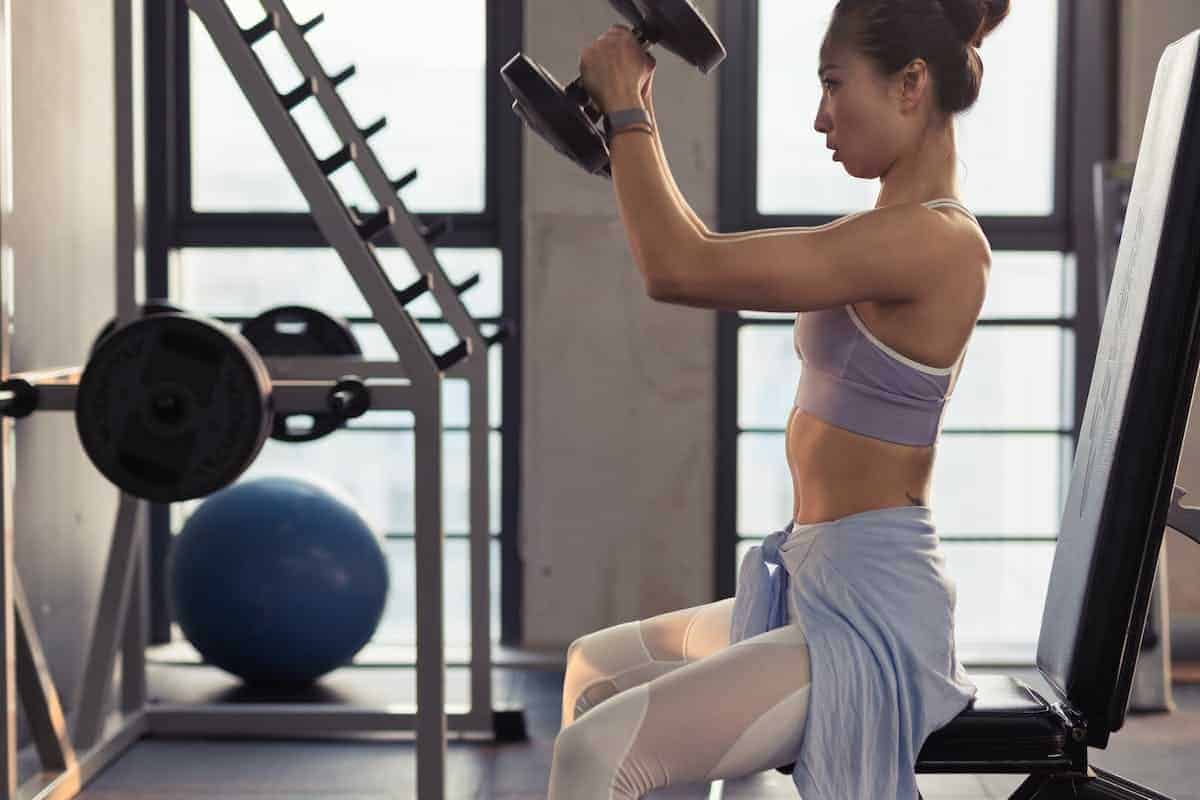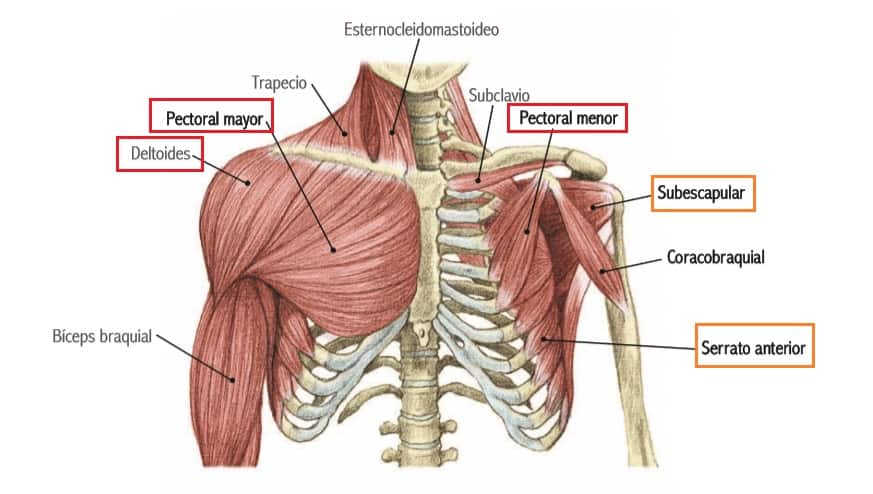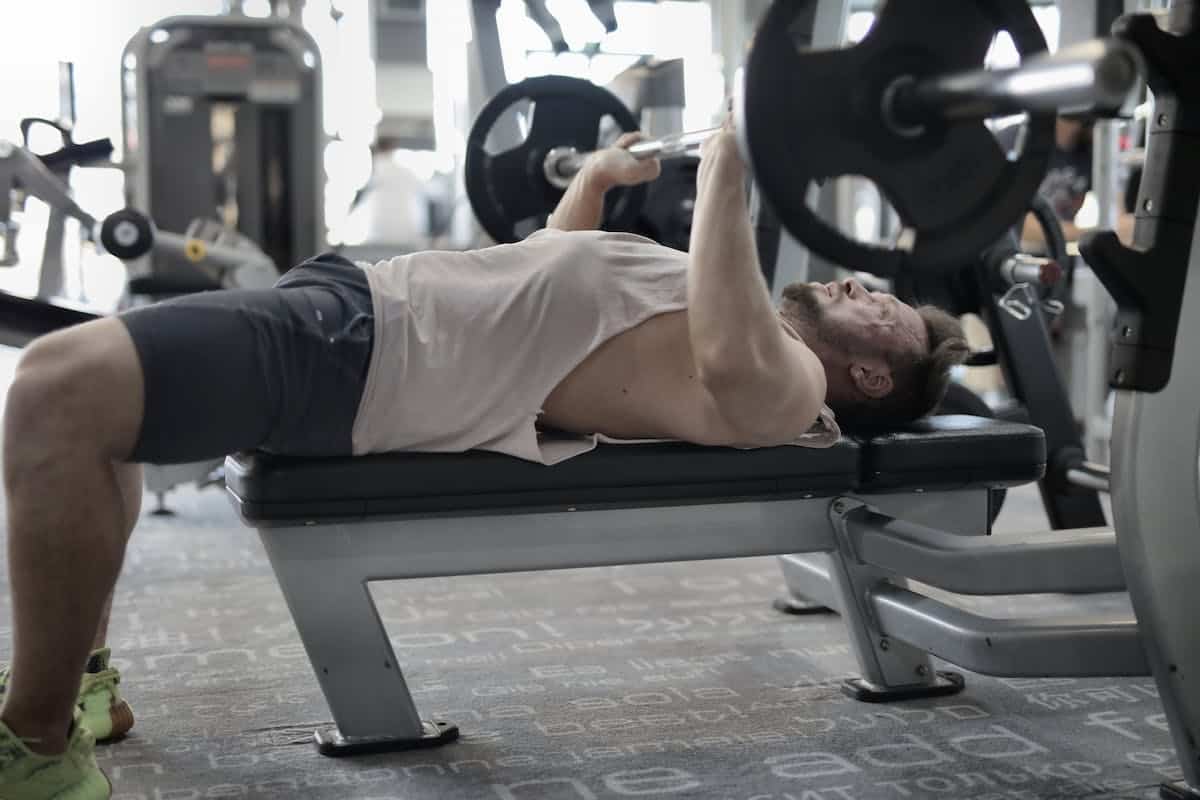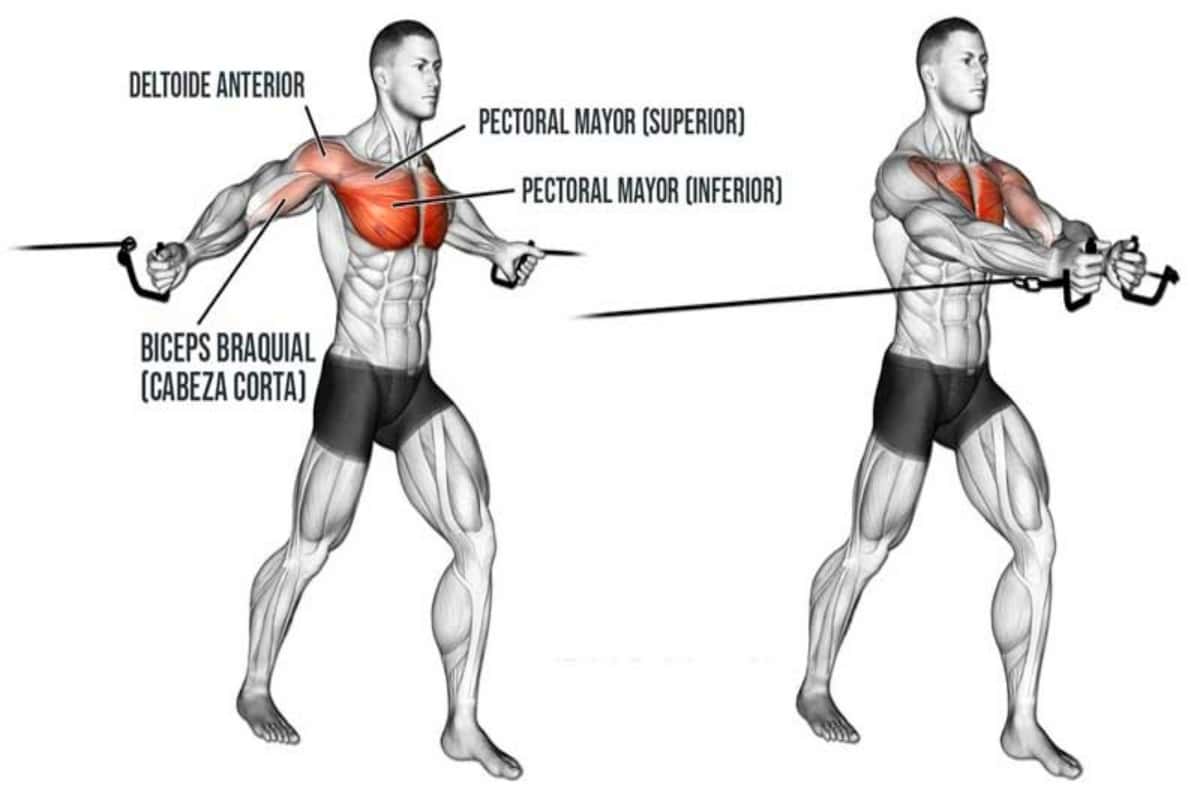The pectorals are muscles located in the chest area. Anatomically, the pectorals of men and women are the same. However, the development and appearance of the pectorals are different because women have their pectorals covered by breast tissue.
In this article, we analyze in detail the anatomy, movements, and exercises related to the pectoral muscles, especially the training of women’s pectorals.
Based on scientific evidence, this article will help you understand the benefits that pectoral training produces in a woman’s body.
Women’s pectoral anatomy
To understand the functioning of the pectoral muscles, we must first know where they are located in the human body.
The pectorals are muscles that make up the upper body musculature and are divided into the pectoralis major and pectoralis minor muscles.
These muscles are located at chest level, in the anterior area of the thorax. The pectoral muscles are flat and triangular in shape, with the pectoralis major being wider than the minor.
Pectoralis major
The pectoralis major is a large superficial muscle. It is covered by subcutaneous tissue and skin. In women, it is located in the area anterior to the mammary gland.
Its origin is divided into three regions: clavicular, connecting with the clavicle; sternocostal, joining the sternum and ribs; and finally, abdominal, joining with the fibers of the rectus abdominis muscle.
Regarding insertion, the fibers of the pectoralis major insert into the crest of the greater tubercle of the humerus.
The pectoralis major is innervated by the lateral pectoral nerves (C5, C6, and C7) and medial (C8 and T1). Its blood supply is connected to the pectoral branch of the thoracoacromial trunk.
The main functions of the pectoralis major include adduction and medial rotation of the arm at the shoulder joint. Additionally, when acting independently, the pectoralis major facilitates arm flexion through the action of its clavicular head and arm extension through the action of its sternocostal head.
| Pectoralis Major | |
| Origin | Clavicular: anterior surface of the clavicle. Sternocostal: joining the sternum and costal cartilages (1–6). Abdominal: fibers from the rectus abdominis muscle. |
| Insertion | Crest of the greater tubercle of the humerus. |
| Innervation | Lateral pectoral nerves (C5, C6, and C7) and medial pectoral nerves (C8 and T1). |
| Blood Supply | Pectoral branch of the thoracoacromial trunk. |
| Functions | Adduction and medial rotation of the arm at the shoulder joint. Arm flexion (via the clavicular head) and arm extension (via the sternocostal head). |
Table 1. Anatomy of the pectoralis major
Pectoralis minor
The pectoralis minor is a thin, flat, triangular muscle located beneath the chest and specifically beneath the pectoralis major.
Its origin is in the anterior area near the costal cartilages, between the third, fourth, and fifth ribs. It inserts into the medial and superior surface of the coracoid process of the scapula.
The pectoralis minor is innervated by the medial and lateral pectoral nerves. Its blood supply occurs in the thoracoacromial artery.
The main functions of the pectoralis minor include stabilization, depression, abduction, and internal rotation of the scapula. Additionally, it elevates the third, fourth, and fifth ribs, aiding in the inspiration process.
| Pectoralis minor | |
| Origin | Anterior area near the costal cartilages, between 1-5 ribs. |
| Insertion | Medial and superior surface of the coracoid process of the scapula. |
| Innervation | Medial and lateral pectoral nerves. |
| Blood supply | Thoracoacromial artery. |
| Functions | Stabilization, depression, abduction, and internal rotation of the scapula.
Elevates the third, fourth, and fifth ribs, aiding in the inspiration process. |
Table 2. Anatomy of the pectoralis minor.
In summary, to get a general idea, the main function of the pectoralis major is to move the shoulder, and the muscular action of the pectoralis minor is to mobilize the ribs.
Main movements of the pectoral
As described in the previous section, it is essential to know the anatomy of the pectoral to act knowledgeably when performing physical exercises focused on pectoral training.
It is important to know that this muscle acts on three joints: the sternoclavicular joint, the acromioclavicular joint, and the glenohumeral joint.
If we establish the rib cage as a fixed point, the set of pectoral fibers produces the following body movements.
- Adduction: the pectoralis major performs shoulder adduction movements. Adduction is the movement by which a body segment is brought closer to the midline of the body.
- Abduction: the pectoralis minor acts in shoulder abduction movements, moving the arm away from the body’s midline.
- Rotation: the pectoralis major and minor perform internal and medial rotation movements of the arm.
- Flexion: the clavicular fibers produce flexion or antepulsion of the arm up to 60º. In the flexion movement, the arm moves forward and upward from the anatomical position of the body.
- Extension: the pectoralis major acts in the extension of the humerus or retropulsion of the shoulder, bringing the arm backward from the anatomical position.
- Inspiration: the upper fibers of the pectoral help elevate the thorax in the inspiration process.
Exercises for women’s pectorals in the gym
In this section, we will explain the 3 best exercises for women’s pectorals to perform in the gym.
Pectoral training in men and women should not have differences; however, some women do not usually include women’s pectoral work in their training routine due to myths and misconceptions.
Bench press
The bench press is a free weight exercise focused on upper body work, mainly for the development of the pectoral, triceps, and anterior deltoid.
For the execution of this exercise, the subject must lie on a flat bench, with feet on the ground and slightly wider than shoulder-width apart. With the hands, a bar is grasped, held with hands slightly wider than shoulder-width apart.
We place the bar over the chest and push the bar upward with the arms. At this moment, it is important that the back does not lift off the bench. Then, we slowly lower the bar towards the chest.
This exercise can also be performed in different ways: with a bar or dumbbells, on an inclined or declined bench, on a specific machine, etc.
Dips
Dips, also called dips, are an exercise in which body weight is used to work the upper body muscles, especially the women’s pectoral.
This exercise primarily works the pectoral muscles, triceps, and anterior deltoid.
[article ids=”83220″] For its execution, we must position ourselves between two parallel bars and lower the body downward, bending the elbows. Then, push upward with the arms. The legs should be bent.
Before performing dips, it is advisable to perform this exercise on the specific machine for it, which helps in its guided movement to learn the correct execution technique.
For more information about this exercise, read this article.
Cable crossovers
The cable crossover exercise is a good alternative to work the women’s pectoral muscle.
One of the advantages of performing this exercise is working both sides of the body simultaneously, which helps achieve more symmetrical muscle development. Additionally, this exercise is very complete for working the pectoralis major and pectoralis minor, in their full range of motion.
This exercise can be performed seated or standing and with high or low pulleys. For its execution with high pulleys, we place the pulleys at shoulder height and grasp the handles with the hands.
The feet can be placed open, shoulder-width apart, or one in front of the other, depending on individual comfort.
We lean the torso forward with the elbows slightly bent and try to bring the two hands together with force.
Remember that it is important to warm up before performing any exercise and consult a professional for proper guidance and to avoid injuries.
Exercises for women’s pectorals at home
Many women, due to lack of knowledge or false beliefs, do not train their chest. Well, in this section, I suggest 2 exercises to train the women’s pectoral that are simple, easy to execute, and with many gains at the muscular and aesthetic level.
These exercises can be performed at home, as the only necessary equipment is dumbbells, and even if you are a beginner, you can perform them with two water bottles.
Push-ups
Push-ups, also known as push-ups, are among the best exercises to work the women’s pectoral, arms, and abdomen.
This exercise has infinite variations, but for initiation, it is recommended that the knees are supported on the ground.
Lying face down, with the knees supported and the arms slightly bent and open a little wider than shoulder-width apart.
The goal of the exercise is to lower the body by bending the elbows until almost touching the ground and then push the ground forcefully to rise back to the starting position.
Dumbbell flyes
This exercise is one of the most basic and effective for working the women’s pectoral. It can be done in multiple ways: seated in a chair, on a flat bench, inclined bench, standing, or supine.
[article ids=”63405″] For its execution, we need two dumbbells and a bench; it can also be performed lying on the floor on a mat. The weight of the dumbbells will depend on your level, start with a light weight and gradually increase as you gain strength.
We lie on a bench in a supine position with feet on the ground. Hold a dumbbell in each hand and extend the arms vertically over the chest, with the palms facing each other.
Keeping the elbows slightly bent, open the arms laterally, moving the dumbbells away from the body. Then, bring the arms back to the starting position, maintaining control at all times.
Benefits of women’s pectoral training
It is scientifically proven that training the pectoral generates gains in strength, muscle, and aesthetically in physical appearance.
The most important benefits that women’s pectoral training provides are the following:
- Strengthening and increasing muscle mass in the pectoral area. Women’s pectoral training helps strengthen and develop the pectoral muscles.
- Breast enlargement and therefore improves physical appearance and self-esteem.
- Toning of the pectoral, shoulder, and triceps muscles.
- Improves breathing, as the muscles in that area help in the breathing process.
- Helps improve body posture and prevent back problems.
- Calorie burning. Women’s pectoral training involves the activation of large muscles, which helps increase calorie expenditure during training and resting metabolism.
- Improvement of cardiovascular endurance. Pectoral training can help improve cardiovascular endurance, as it requires sustained and continuous effort during training.
In general, pectoral training is beneficial for improving physical performance, aesthetic appearance, and overall health.
It is important to perform the exercises properly and under the supervision of a professional to achieve the best results and avoid injuries.
Breast augmentation surgery and physical exercise
Breast surgery, also known as breast augmentation surgery or augmentation mammoplasty, is one of the most popular cosmetic procedures worldwide.
Many women wish to increase the size of their breasts for aesthetic reasons or to restore shape and firmness after pregnancies or weight loss. However, some women worry that this surgery may affect their ability to perform pectoral training exercises.
One of the famous questions many women ask after undergoing breast surgery is the following: Can you exercise after breast augmentation surgery?
The answer is yes, under the supervision of a professional and with a prescribed treatment. This surgery allows improving the physical appearance of women and self-esteem, thus improving the quality of life.
What criteria should be considered when practicing physical activity after breast surgery?
In the first weeks after surgery, it is common to experience swelling and discomfort in the breasts. Therefore, it is important to avoid intense pectoral exercises during this period to allow the tissues to heal and recover properly.
The doctor may recommend stretching exercises and gentle movements to maintain flexibility and blood circulation in the area.
After the first weeks, it is generally allowed to gradually resume pectoral training. However, it is important to start with low-intensity exercises and progressively increase the intensity.
Additionally, care should be taken not to overload the pectoral muscles, especially if additional weight is used or exercises with machinery are performed.
It is important to mention that the shape and size of breast implants can affect the way certain exercises are performed. For example, in some cases, women may experience a decrease in range of motion or discomfort in movements such as push-ups or bench press.
In these cases, modifications to the exercise technique can be made, or alternative exercises that do not cause discomfort can be chosen.
It is essential to communicate with the plastic surgeon and a specialized trainer or physiotherapist throughout the recovery and training process. They can offer personalized advice and specific recommendations considering the individual needs of each woman.
In summary, breast augmentation surgery should not prevent women’s pectoral training, as long as medical indications and recommendations are followed. Recovery may take time, and it is important to be patient and gradual in reintroducing pectoral exercises.
5 reasons for women to train their chest
Women’s pectoral training is more associated with males than females in training routines. One of the reasons this occurs is because some women think that training pectorals will decrease their breasts.
Is it true that pectoral training reduces the chest?
No, it is not true that training pectorals will reduce a woman’s breasts. What happens is that the image of a female bodybuilder is associated in the mind, where their breasts appear flat due to the low body fat percentage.
The chest is a part of the body composed of fatty tissue, so when training regularly, body fat levels decrease, and in turn, the fat in a woman’s chest also decreases.
Therefore, this statement is completely false and a myth that has been talked about for years.
Here are 3 reasons why women should train their pectorals:
- Work all muscles. All muscles of the body should be trained, as each has a specific function, and together, all muscles act to mobilize the human body.
- Involvement of other body parts. When we train the chest, we are also training shoulders and arms. Therefore, if we do not train the chest, there will be muscle fibers of certain muscles that are not developing.
- Breast enlargement. Training the pectorals contributes to increasing muscle mass and consequently making the breasts appear larger.
Conclusions
The women’s pectoral is a muscle located in the thorax region and forms part of the upper body musculature. Among its movements, adduction and rotation of the arm stand out.
Pectoral training is important for both men and women.
In the case of women’s pectorals, it is interesting that they include exercises focused on women’s pectorals in their training routine, as they will gain muscle strength, strengthening of the arms and shoulders, and aesthetic improvement at the whole body level.
Bibliographic references
- Basile, F.V. and Oliveira, T.S. (2022). Exercise after breast augmentation: A randomized controlled trial. Plastic and reconstructive surgery, 149(1), 18-24. Exercise after Breast Augmentation: A Randomized Controlled Trial – PubMed (nih.gov)
- Blazek, D., Kolinger, D., Petruzela, J., Kuboyy, P., Golas, A., Petr, M., Pisz, A. and Stastny, P. (2021). The effect of breathing technique on sticking region during maximal bench press. Biology of Sport, 38(3), 445-450. The effect of breathing technique on sticking region during maximal bench press – PMC (nih.gov)
- Boyle, M. (2017). Functional training applied to sports. Editorial Tutor. Madrid.
- Calatayud, J. (2016). Alternative strength training methods to increase muscle activation in push exercises. Doctoral dissertation, Universitat de Valencia.
- Jurad, D. and Wenzel, D. (2002). Breast augmentation in athletic women: A retrospective survey assessing pectoral muscle function and implant aesthetics post-augmentation. Aesthetic Plast Surg, 46(3), 1075-1081.
- Kapandji, I. A. (2012). Joint physiology. 6th Edition. Panamericana. Madrid.
- Marchante, D. (2019). Bench press: practical tutorial. PowerExplosive.
- Párraga Cabeza, A. (2022). Complications related to breast augmentation with silicone implants: a literature review.
- Paulsen, F., and Waschke, J. (2018). Atlas of human anatomy vol 1: General anatomy and musculoskeletal system. Elsevier.
- Sarbak, J.M. and Baker, J.L.Jr. (2004). Effects of breast augmentation on pectoralis major muscle function in the athletic woman. Aesthetic Surgery Journal, 24(3), 224-228. Effects of Breast Augmentation on Pectoralis Major Muscle Function in the Athletic Woman | Aesthetic Surgery Journal | Oxford Academic (oup.com)
- Weinek, J. (2013). Sports anatomy. 5th Edition. Paidotribo. Barcelona.




